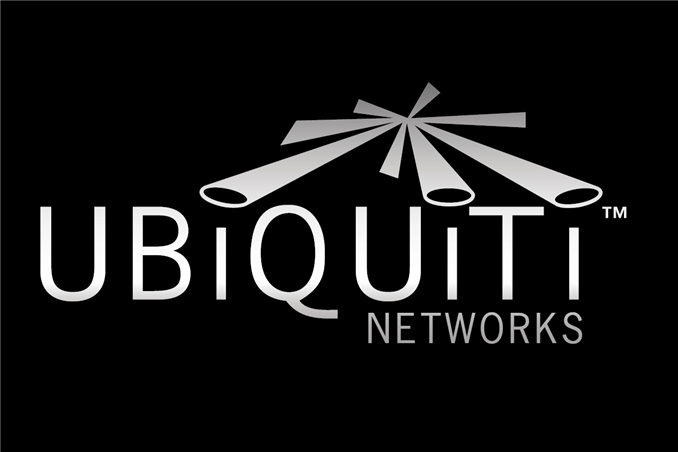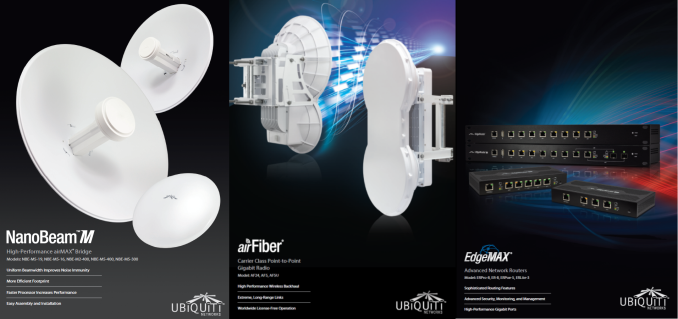Ubiquiti Networks Introduces Next-Gen Fixed Wireless Broadband Infrastructure
by Ganesh T S on October 21, 2013 5:45 PM EST- Posted in
- Enterprise
- ISP
- Ubiquiti Networks

Ubiquiti Networks is a B2B company with a very interesting business model. At the enterprise level, companies employ dedicated sales teams to attract clients and increase revenue. Ubiquiti claims that such teams are responsible for approximately 40% of the consumers' end cost. Ubiquiti does away with these teams and passes on the savings to the consumer, which results in a disruptive pricing model. We have already covered Ubiquiti before, when they launched the first 802.11ac access point for enterprise Wi-Fi networks.
One of the most interesting product lines from Ubiquiti is their fixed wireless broadband lineup. The airMAX, airFiber and EdgeMAX products helps Wireless Internet Service Providers (WISPs) to provide broadband access to remote and sparsely populated areas (think of outposts in Alaska with populations in the hundreds or low thousands). Laying wired cables to such areas might not make economic sense and this is where Ubiquiti steps in. Fixed wireless broadband providers have rapid ROI since they do not require trenching and can also be deployed in areas with limited infrastructure. The WISP business is still a niche market, but analysts predict that it is growing at a 21.8% CAGR through 2017. This represents a $5.9B revenue opportunity for service providers next year.
The new products from Ubiquiti introduced today include:
- airMAX: This provides point-to-multipoint and point-to-point fixed wireless access (last mile infrastructure). Within this product line, we have the airMAX NanoBeam CPE (consumer premises equipment) family based on Ubiquiti's proprietary airMAX TDMA protocol. This products comes in a couple of different form factors for deployment flexibility. One form factor is the dish reflector design with three different models: 2.4 GHz 400mm, 5 GHz 400mm and 5 GHz 300 mm, while the other all-in-one design integrates both antenna and radio to provide a more efficient footprint. This one also has a faster processor and comes in two models, 5 GHz 16dbi and 5 GHz 19 dBi.
- airFiber: This provides high performance point-to-point wireless access (backhaul platform). It operates in the unlicensed 5 GHz band and primarily targeted at carrier backhauls. However, it can also be used for building-to-building networking in enterprises. The new generation product can provide 1.0+ Gbps aggregate throughput and, with the new xRT (eXtended Range Technology), can provide a range of over 100 kms. It is priced at $2000 per link, which is very disruptive. The airFiber family also includes a 24 GHz model which provides 1.4+ Gbps real data throughput with a 13 km range.
- EdgeMAX: This is a routing and switching platform for the network edge and comes in two models, EdgeRouter and EdgeRouter Pro. These are 8-port rack mountable switches and the Pro version comes with two SFP ports. Both are capable of 2 million packets per second throughput.
The new products are scheduled to ship in Q4 2013. Ubiquiti also announced the beta release of the Ubiquiti World Network, an endeavour to create a directory of WISPs (Ubiquiti customers). It is envisaged that the directory would make it easier for end consumers to find Internet providers servicing their location.
Source: Ubiquiti Networks











21 Comments
View All Comments
extide - Tuesday, October 22, 2013 - link
This ubiquity stuff is in the million packet per second class of gear, that means it uses dedicated hardware asics to do packet switching. You will NEVER see a software based router (like any consumer router or any router platform that runs on commodity pc hardware) get anywhere near the million packet/sec benchmark. Totally different class of gear dude. You are asking amateur questions on a page regarding enterprize gear. If you are considering a deployment that would necessitate gear at this level, then you should also have a much higher knowledge level to go along with it.name99 - Saturday, October 26, 2013 - link
Why do you insist on assuming that you understand our deployment target better than we do?Our target bandwidth is 15Mbps. A PPC Mac can easily route that, as evidenced by using internet sharing on it. We are buying the UniFi 2.4GHz bgn boxes, not the high end 5Ghz ac boxes.
We will probably buy a Draytek box because it gives us a few other advantages, but you would do well to realize that not everyone in the world requires data center hardware and performance.
(And don't try to save your butt by now telling me that you know better than we do that 15Mbps will not meet our needs. Do you know the country where we are deploying? Do you know the target market?)
extide - Tuesday, October 22, 2013 - link
You should look into pfSense for your routing and firewall needs. It can handle all of that no problem.sligett - Tuesday, October 22, 2013 - link
I can't imagine depending on a Mac or Windows client like that. For an old reliable router, you could get an HP 7102dl for $60 or so on ebay. I don't know current HP routers.eanazag - Tuesday, October 22, 2013 - link
Is the connection sharing limit a factor in Windows server software? I am not totally understanding what the restrictions here are. I mean if you are throwing out 20 of these devices you can't afford Windows server? Windows server can run on crappy hardware.I know from experience you can setup any IP address range you want for DHCP on Windows server. If you're just running DHCP and DNS any hardware you get (Intel) is overkill.
extide - Tuesday, October 22, 2013 - link
None of your approaches are a good idea. Wou want to use a routed topology behind a single NAT gateway for internet access. if you have 45+ ap's and several clients on each one, and everything is in a single broadcast domain you will kill your wireless with broadcast traffic! You need to segment the network into several routable subnets which wont pass broadcast traffic, and utilize different IP subnets. This way every device could connect to any other device (if you wanted them to, or you could use firewall rules at each router level to block traffic that you don't want), and you will not have a major broadcast storm going on all the time.Also do not do a double NAT setup. This is a dumb solution only used by people who dont know what they are doing
And Windows ICS, REALLY? This has to be a joke. I mean for a setup like this you could probably get away with a high end soho router or a pc based router like pfSense.
chrnochime - Tuesday, October 22, 2013 - link
What I though too. Not sure why he doesn't list segmenting into routable subnets as an option. Admin overhead, too many subnets to deal with perhaps?blwest - Thursday, October 24, 2013 - link
Sounds like you need to hire an expert.DanNeely - Tuesday, October 22, 2013 - link
I'm 95% sure the WISP a friend of mine's parents use is 2.4ghz: Based around 802.11b with high gain directional antennas. Their neighbors include a lot of farmers; so the spectrum is relatively uncluttered.CecileWamsley - Monday, October 28, 2013 - link
my Aunty Eleanor got a nice twelve month old Suzuki Kizashi by part time working online from home... try this site... http://smal.ly/8wUo2